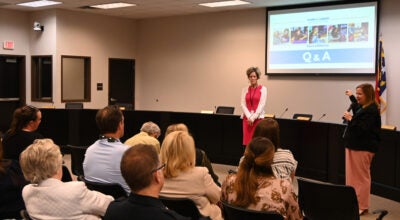UNCG studies benefits of food at new center on N.C. Research Campus
Published 12:00 am Monday, May 19, 2008
By Emily Ford
Salisbury Post
KANNAPOLIS ó Everyone knows about vitamins and minerals. What they’re called, where to find them and what they do.
We eat carrots for vitamin A and better vision. We grab an orange rich in vitamin C to boost the immune system.
We drink milk and chomp leafy greens for strong bones and teeth, thanks to the calcium they contain.
But foods, especially plants, have more to offer than just B12 and zinc.
Fruits, vegetables and whole grains are full of mysterious constituents that, when eaten, may slow aging, protect against heart disease, fight cancer and more.
These nutritional gems are called bioactive food components, and a new center at the N.C. Research Campus run by the University of North Carolina at Greensboro aims to discover how they promote health and prevent disease.
“There are benefits of food beyond vitamins and minerals,” said Dr. Debbie Kipp, interim director for the UNCG Center for Research Excellence in Bioactive Food Components. “Our scientists will work to find the health benefits of these compounds.”
UNC-Greensboro is one of seven universities with a presence in Kannapolis, where billionaire Dole Food Co. owner David H. Murdock is building a 350-acre biotechnology hub dedicated to health and nutrition research.
Unlocking mysteries
Researchers around the world have identified many bioactive food components, but exactly how they work remains a mystery.
UNC-Greensboro will study cellular and molecular mechanisms of the compounds, trying to answer fundamental questions in part by using the extremely sensitive scientific instruments at the $1.5 billion N.C. Research Campus.
While still less well known than vitamins and minerals, some bioactive food components have started making a name for themselves.
Isoflavones found in soybeans are a kind of bioactive food component.
Red wine has resveratrol, and tomatoes offer lycopene and lutein. Green tea has EGCG.
Understanding these compounds will better explain the role that diet plays in helping people live longer, healthier lives, Kipp said.
“It’s not food coloring,” she said.
Kipp chairs the Department of Nutrition at UNC-Greensboro, which has been studying bioactive food components for years.
Research will continue at the main campus in Greensboro, and scientists there will work closely with their new colleagues in Kannapolis. Graduate students also will play a role at the Research Campus.
Determining direction
UNC-Greensboro’s specific research focus in Kannapolis will depend on who directs the new center.
By this fall, the university plans to hire co-directors with “an internationally known track record of research,” Kipp said.
The directors’ interests and specialities will determine which bioactive food components, as well as which health benefits, the center will study.
When recruiting a leader, sometimes called a director or principal investigator, to a scientific institute, a university considers not only individuals but also their research projects, which often have gone on for years.
Every new institute in Kannapolis reflects the research focus of its top leaders.
The UNC Nutrition Research Institute will focus in part on nutrition and brain development, a speciality of director Dr. Steven Zeisel.
The MURDOCK Study, led by Duke University, will focus on four diseases, including hepatitis and cardiovascular disease, specialities of principal investigator Dr. Rob Califf and co-investigators Dr. John McHutchison and Dr. Geoffrey Ginsburg.
And the N.C. State Fruit & Vegetable Science Institute last week hired director Dr. Mary Ann Lila, who specializes in bioactive food components, particularly those that help counteract chronic disease and promote endurance.
So two universities in Kannapolis will research these little-understood compounds.
Kipp called that good news.
“There are so many bioactive compounds to study and so many research approaches to use that the research opportunities are plentiful,” she said.
N.C. State and UNC-Greensboro will collaborate extensively, she said.
Kipp said she already has talked to Lila by phone and will continue discussions with her as UNC-Greensboro narrows its search for co-directors.
Natural fit
While many people know that UNC-Chapel Hill studies nutrition and N.C. State specializes in plant science, far fewer know about the bioactive food component program at UNC-Greensboro or the zebrafish at N.C. Central University.
The N.C. Research Campus gives these smaller schools “a chance to shine,” said Lynne Scott Safrit, president of campus developer Castle & Cooke North Carolina.
After Murdock conceived of the Research Campus in 2005, he first recruited UNC-Chapel Hill and N.C. State because of their reputations for research, Safrit said.
But Murdock soon learned that many schools in the UNC System have top-notch research programs, “albeit not as well known,” Safrit said.
The novel concept of putting UNC-Chapel Hill and N.C. State together on the same campus soon evolved to including other universities as well.
“We wanted to give the opportunity to some smaller schools to showcase things they’re really great at,” Safrit said.
N.C. Central has a research program featuring zebrafish, which are an important model organism in the study of genetics. N.C. A&T University specializes in post-harvest technology, crucial to the development of new agricultural products.
And UNC-Charlotte has bioinformatics, a computer-based speciality needed to manage the huge amount of data that scientists in Kannapolis will generate.
Murdock invited all these universities to join the Research Campus.
“It was just a natural fit,” Safrit said.
Duke University came on board, and Murdock gave the School of Medicine $35 million to launch a long-term medical study that bears his name.
Appalachian State University is expected to join this fall.
UNC-Chapel Hill and N.C. State each will receive about $10.5 million per year from the General Assembly at full funding, while each of the smaller schools will receive $1.5 million or less.
Those dollar amounts don’t matter in Kannapolis, Safrit said.
“These are all equal partners on campus,” she said.
A crucial role
Because the campus was designed to make the universities rely on one another, smaller schools like UNC-Greensboro play a crucial role, Safrit said.
“It’s really exciting that the collaboration is not just the two bigger schools,” she said. “The smaller schools are putting forth their best research efforts and best minds.
“They are important to the future of the campus.”
Acknowledging the role of every school is “vital to a cohesive environment,” Kipp said. “Everybody brings in a unique piece.”
UNC-Greensboro will occupy part of the fourth floor in the massive UNC Nutrition Research Building along with UNC-Chapel Hill, UNC-Charlotte, A&T and N.C. Central.
“We are all equally excellent in science, we just have different-sized programs,” Kipp said.
N.C. State will share another huge building with Dole Food Co. The two are expected to collaborate on producing and commercializing “super” fruits and vegetables with higher nutrition profiles.
UNC-Greensboro’s research will help inform N.C. State’s project.
Both buildings are expected to open this fall.
Kipp commutes to Kannapolis several times a week and said she’s still amazed when she takes exit 63 and the Research Campus comes into view.
“Unless you see it, you just don’t get a feel for the magnitude,” she said. “Kannapolis is on the map.”Contact Emily Ford at eford@salisburypost.com.





